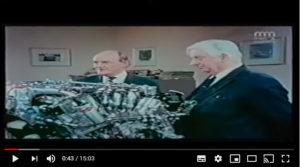Harry Mundy
Ex-Technical Editor of ‘The Autocar’ and Engine Designer who worked on XK, V12 and AJ6 Engines
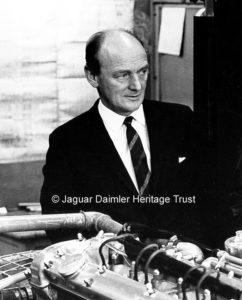
Harry Mundy
Born in 1915, Harry Mundy was a British car engine designer and had been a technical editor of ‘The Autocar’ for eight years. He was heavily involved in the design of the Coventry Climax engines and then the production version of the Jaguar V12 engine after Jaguar took over Coventry Climax in 1963, going on to develop the AJ6 engine before his retirement in 1980.
After going to King Henry VIII School in Coventry, he took an apprenticeship with Alvis, but left them in 1936 to join English Racing Automobiles (ERA) as a draughtsman. In 1939 he returned to Coventry to work at the Morris Engines factory and in 1946 he worked for British Racing Motors (BRM) as head of the design office where he was involved in the design of the BRM V16 Formula One engine. In 1950 he worked as a chief designer for Coventry Climax and when Jaguar acquired Climax in 1963, his lifelong friend Walter ‘Wally’ Hassan persuaded him to return to engineering and together with William Heynes, had a major hand in designing the Jaguar V12 production engine.
Having seen the XK engine through its development phase and installed in the XK120, Walter Wally Hassan left Jaguar and joined Coventry Climax. Here he worked with Harry Mundy on an engine; they designed the Featherweight (FW) lightweight overhead camshaft unit intended for use for fire pumps, securing an order for 5,000 engines. The FW was developed over the years and served faithfully with most of the fire departments in the UK also seeing service with fire-fighters overseas.
Having designed an efficient lightweight engine, Mundy and Hassan continued developing the FW for other uses and exhibited it at the Motor Show in the marine section to attract the attention of boat builders. Instead it attracted the attention of Colin Chapman of Lotus Cars and John Cooper who was building small 500 cc powered racing cars. Colin Chapman saw the potential of the unit for Formula 1 and Lotus F1 cars were soon winning races. Driving a Coventry-Climax-powered Lotus, Jim Clark became World Champion twice with Team Lotus. Coventry Climax engines gave Lotus further successes in Formula 2 and in the Le Mans 24 hour race.
Hassan and Mundy claimed they never intended to design a racing engine, the pump’s requirement, of lightweight and continuous high revs just matched the needs of a racing car.
In 1955 Mundy moved into journalism as Technical Editor of ‘Autocar’ magazine while also doing some work for Lotus on the twin cam version of their Ford Engine.
Walter Hassan continued his work on the race engines until 1963 when Jaguar bought Coventry Climax. This brought Hassan back into the fold as he had worked for SS Cars from 1938 to the early 1950s and he persuaded Mundy to join him at Jaguar.
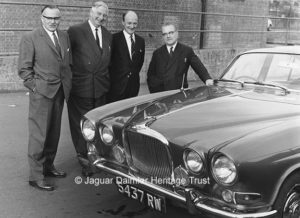
Heynes, Hassan, Mundy & Baily
with Prototype Jaguar Mark X
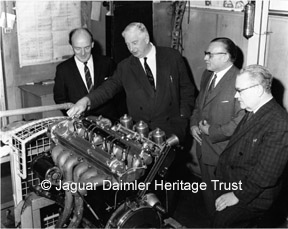
Harry Mundy, Walter Hassan, William Heynes & Claude Baily
with Triple Carburettor XK Engine
on Test Rig
Jaguar now had four of the most talented engineers in the country under one roof. William Heynes and Claude Baily had been working on a V12 engine and they now added the talents of Hassan and Mundy to redesign and work on the project.
The origins of a Jaguar V12 engine can be traced back to 1952 when an ‘XK 4.9-litre V12 engine’ is noted in a list of Jaguar Works Order Numbers for experimental projects. In effect the unit consisted of two six-cylinder XK heads mounted on a new V12 block. Such a unit was intended to power the proposed Le Mans-type racing car XJ13 and a variant to be used on saloon models.
When Hassan returned to Jaguar he inherited the various drawings made by Baily and Heynes and set to work with Harry Mundy on a revised design. Hassan found the existing V12 too heavy and would not fit the saloon car for which it was intended, the Jaguar XJ6 then in design. Together they set about designing an alternative V12 engine, with various configurations being proposed and tested. Heynes, as Chief Engineer, and Baily were both closely involved with the new unit and were present with Mundy on the afternoon of 6th August 1964 when engineer Jim Eastick started the V12 engine for the first time. Heynes wanted to be present for the first firing of the engine but Eastick wanted to make sure it ran so had actually fired it up before lunch just to make sure. The engine was run for a few days and then dismantled on 12th August for examination by Mundy and Vandervell, the bearing manufacturers.
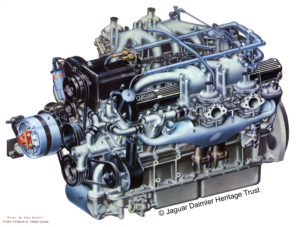
1971 Jaguar V12 Engine
with Four Strombergs
One of the early engines tested in 1965 failed causing damage to two cylinders, so this block was later used with a different crankshaft for testing as a V8 during 1965 and 1966. Further testing on the V8 variant continued until November 1971 when the project was cancelled.
Eventually, after many years of testing, the 5.3 litre Jaguar V12 was launched in 1971 in the Series 3 E-type. This new engine, although also planned to power the saloon cars, was launched in a sports car following the precedent set in 1948 when the XK engine had been launched in the XK120.
Mundy accompanied Sir William Lyons to the US for the launch of the V12 E-type into the American market. Although the engine was later developed for racing, ‘Car’ magazine quoted Mundy as saying “forget all about racing – this is no way this can be made into a racing unit”.
Mundy had also been working on a longer stroke version of the V12 engine which would have taken it up to 6,413 cc. The initial design called for a taller block but to save cost a number of prototype engines were made by inserting a sandwich plate to lengthen the block and installed in test vehicles. Mundy costed this option up fully to put it into production, but it was deemed too expensive and the project was shelved.
Mundy was also involved in gearbox design and worked on a 5-speed manual gearbox to handle the torque of the 6.4 litre engine. Five complete gearboxes were built and tested, one of them covering more than 50,000 miles without problems. Again it was believed that the costs (£64-65,000) of putting this into production would be too high and as automatic transmission was becoming the standard for Jaguar’s more powerful cars, particularly for the US market, this project was also shelved.
Raymond Baxter interviewed Walter Hassan and Harry Mundy about the design and merits of the V12 engine, which is now available in two parts on YouTube (just under 19 minutes viewing time).
Hassan retired in 1972 and Mundy succeeded him.
One year after the launch of the Series 3 E-type, the V12 engine was fitted to the XJ saloon which was known as the XJ12 and was to win the accolade of ‘Car of the Year’. Daimler versions of the XJ12 were called ‘Double-Six‘, bringing back a famous Daimler model name from pre-World War Two days.
Southam based engineer and engine tuner, Ralph Broad, won the 1974 British Saloon Car Championship in his tuned Triumph Dolomite Sprints and convinced Leyland Cars (parent company of Jaguar following the merger) that he could win the European Touring Car Championship with V12 powered, and Broad tuned, XJSes. Broad told Mundy he was getting 420 bhp out of the engine, instead of the standard 272 bhp, which Munday refused to believe – saying he would eat his hat. When the tuned engine was later demonstrated to Mundy at Southam it did indeed produce 420 bhp, but no hats were consumed. The engine ran a bit rough but the problems were resolved and smoothed out and used for racing, although in the later Broadspeed XJC rather than the originally planned XJS.
The E-type finished production in 1975 and was replaced by the XJ-S, being launched with a fuel-injected version of the V12 engine. The engineering of the XJ-S had been done by Mundy and Bob Knight with the body being designed by Malcolm Sayer.
After the merger into Leyland Group it was announced that Jaguar engineering would remain autonomous, rather than being absorbed into the Rover-Triumph office, and Bob Knight was in overall charge with Mundy responsible for powertrain development.
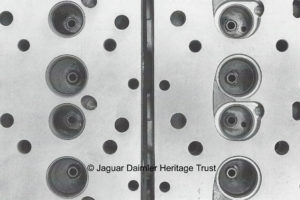
Original Flat Head & May Fireball Head
The fuel crises of the 1970s led to the need to improve the fuel efficiency of the extremely thirsty V12 engine and Mundy and his team put a lot of work into developing a solution. In 1976 the ideas for combustion chamber design of Swiss engineer Michael Mays came to Jaguar’s notice. Harry Mundy picked them up and a couple of test engines were developed which were tested by Norman Dewis by mid 1978. This was ultimately to enter production and appeared one year after his retirement with the introduction of the ‘May Fireball’ cylinder head in 1981 in the XJ-S H.E. (high efficiency).
One test car pulled three of Mundy’s pieces of engineering together. An XJ6 Series 2 saloon was built with one of Mundy’s 6.4 litre V12 engines, fitted with Mays heads and his 5-speed manual gearbox – reported as being ‘exceptionally quick’. It never went into production and like most test cars was dismantled.
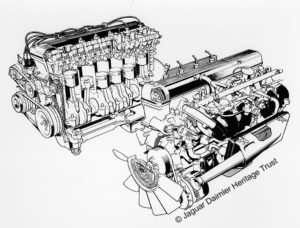
24 Valve AJ6 Engine
Mundy was heavily involved in developing the AJ6 engine as a replacement for the ageing XK engine which was ultimately to remain in production for over 40 years. Design and work started on this in the mid 1960s and a prototype was running by November 1972. A 6 cylinder engine, slanted at 30 degrees, was tested in a vehicle, recording 150 bhp at 4,500 rpm and 171 bhp at 5,500 rpm.
Walter Hassan, who had been leading the development team, retired in 1972 leaving Mundy to carry on with the engine.
Ron Burr joined Mundy on the engine design, which now had the unit at a slant of 15 degrees from the vertical rather than 30 degrees. It was found that the new angle gave sufficient under-bonnet clearance without creating access problems to the underside of the engine. Though the records are unclear, it would appear that it was around this time that the name “Advanced Jaguar Six-Cylinder” or “AJ6” was applied. The advances included a light alloy block (the XK block was cast iron) and chain drive in place of a toothed belt for the twin overhead camshafts. Several examples of the new engine began to take shape in the Engineering Department but it was not until 1979 that a complete 24-valve (4 valves per cylinder), twin-overhead-cam, 3.6-litre AJ6 unit was ready to be bench tested.
Mundy retired in late 1980, at the same time as Bob Knight, but continued to help as a consultant with Trevor Crisp taking over the power unit engineering. Under the British Leyland regime £6 million was signed off for the installation of the engine production line at the Radford Plant and it went into production, being launched in the Cabriolet version of the XJS in 1983.
Harry Mundy passed away in 1988.
Authors: Shihanki Elpitiya and Tony Merrygold
© Text and Images – Jaguar Daimler Heritage Trust
Sources and Further Reading:
-
Harvey, Chris, E Type: End of an Era (The Oxford Illustrated Press 1977)
-
Grimsdale, Peter, High Performance: When Britain Ruled the Roads (Simon & Schuster UK, 2020)
-
Lord Montagu of Beaulieu and foreword by HRH Prince Michael of Kent, Jaguar (Quiller Press, 1997)
-
Mennem, Patrick, Jaguar: An Illustrated History (The Crowood Press Ltd, 1991)
-
Whyte, Andrew, Jaguar: The Definitive History of a Great British Car (Patrick Stephens Limited, 1990)
-
Daniels, Jeff, Jaguar: The Engineering Story (J H Haynes & Co Ltd, 2004)
-
Porter, Philip, Jaguar: E-Type The Definitive History (Porter Press International, 2015)
-
Thorley, Nigel, Jaguar in Coventry: Building the Legend (Breedon Books Publishing Co Ltd, 2013)
-
Skilleter, Paul, Norman Dewis of Jaguar: Developing the Legend (PJ Publishing Ltd, 2017)
-
Porter, Philip and Skilleter, Paul, Sir William Lyons: The Official Biography (Haynes Publishing, 2001)
-
Bingham, Phillip, The All-American Hero and Jaguar’s Racing E-types (Porter Press International, 2020)
-
Porter, Philip, The Most Famous Car in the World: The Story of the First E-type Jaguar (Cassell, 2000)
-
Wilson, Peter D., XJ13: The Definitive Story of the Jaguar Le Mans Car and the V12 Engine That Powered It (PJ Publishing, 2011)
